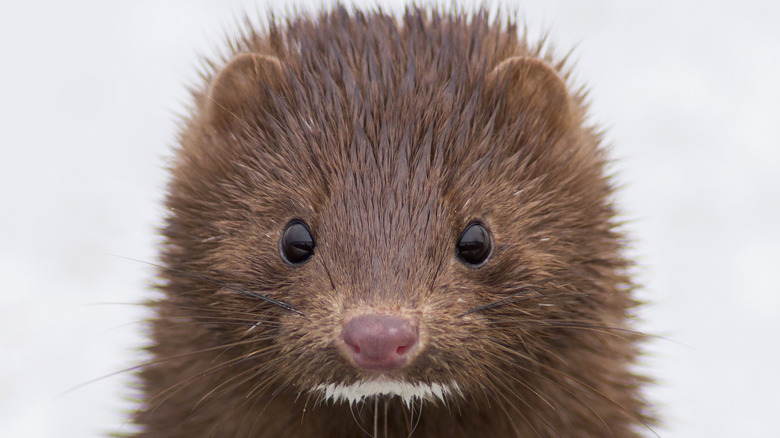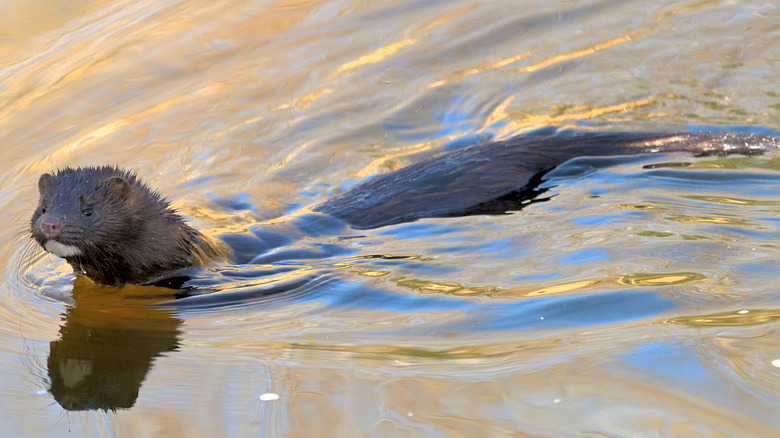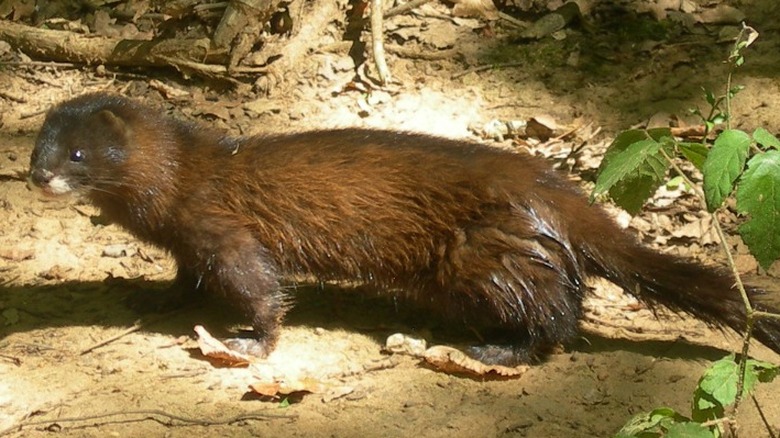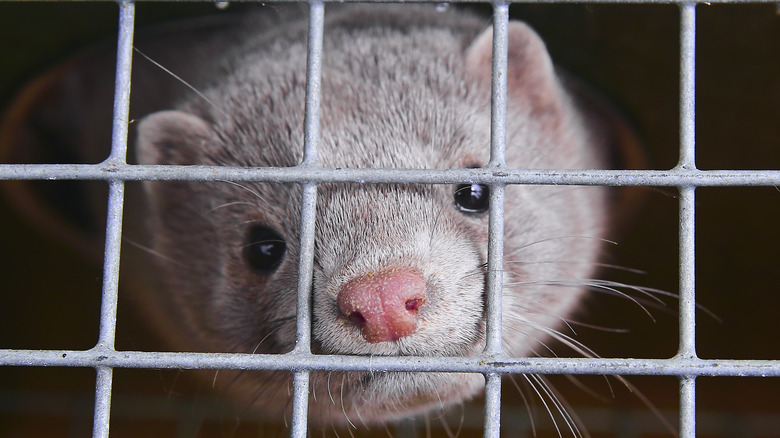Where Do Minks Live?
Minks are an animal that, sadly, may be more recognizable to humans dead than alive. The iconic mink coat adorned the shoulders of stars from Judy Garland to Janet Jackson, and was once synonymous with glamour (via The New York Times). But where do these sleek creatures come from? Minks are mammals that live near water, which explains their waterproof fur that makes them a target of the fashion industry, according to The Humane Society of the United States (HSUS). They are in the weasel family, according to Britannica, and look similar to ferrets, according to HSUS.
There are two species of mink: the European mink and the American mink, according to Britannica. The European mink once roamed from northern Spain to Russia's Ural Mountains. However, it now only lives in Spain, France, Ukraine, Romania, and Russia, according to the International Union for Conservation of Nature and Natural Resources (IUCN) Red List. A wild population has also been reintroduced in Estonia. The American mink's original range extended through most of the North American continent, with the exception of the Southwest, according to Britannica. Unlike the European mink, the American mink's habitat has actually expanded. That's because the American mink is favored by mink farmers around the world. Sometimes, the minks escape the farm because of shoddy enclosures, extreme weather events, or mass releases by animal welfare activists. When that happens, the minks usually do quite well for themselves, and there are now wild American mink populations in Europe and South America.
American minks in the wild
American minks can be found in most parts of the U.S. and Canada, according to Animal Diversity Web. In fact, the only U.S. state where they don't live is Arizona, and the only parts of Canada they don't frequent is the Arctic coast as well as some islands. Their favorite places to live are wooded areas with access to a body of fresh water, like a lake, stream, or pond. The animals also can be found in marshes or near the coast, according to the Chesapeake Bay Program. However, a Michigan study never found mink more than 100 feet from water, according to The National Wildlife Federation. They will frequently sleep at the foot of a tree or a den abandoned by another animal. They also like to hide among rocks or shrubs along the water's edge, according to Animal Diversity Web. Once in the water, they like to be able to explore their watery environment, diving into pools or crevices in search of prey — they're carnivorous, according to Britannica.
For most of the year, minks live alone. Males and females only meet up during the spring to mate. Then the male takes off, and the female raises her children alone. The young set out on their own after six months. But, despite their solitary existence, minks are important for the North American ecosystems they inhabit as predators for fish, small mammals, insects, and amphibians, according to the Chesapeake Bay Program.
Endangered Europeans
The European mink has habitat preferences similar to those of its American cousins. It also likes to live along the wooded banks of streams, rivers, or lakes while finding shelter between tree roots or in abandoned vole burrows, according to Animalia. European minks will also dig their own burrows, which are typically around 20 to 40 feet from a water source. They will typically range along three miles of a stream and find temporary resting places in addition to their permanent burrows. Like the American minks, the European minks live alone except for mating season.
The main difference between the European and American species is that the European species is considered Critically Endangered by the IUCN Red List, while the American mink is a species of Least Concern. The American mink is partly to blame for this discrepancy, but, since the species never asked to be shipped across the ocean to be farmed for its fur and then accidentally released, the buck really stops with the humans who relocated them. European minks were first hunted for their pelts, reduced to extremely low numbers, and then could not compete with the more robust, adaptable American minks when they escaped captivity and entered the ecosystem. In North America, however, the presence of American minks actually means that an ecosystem is healthy, according to The National Wildlife Federation. This is because the animals are very sensitive to pollutants like mercury.
Farm life
There are also American mink living in fur farms around the world. Half of these farms are in Europe, while there are also significant numbers of farms in the U.S., Canada, China, Argentina, and Russia (via People for the Ethical Treatment of Animals). These minks typically live in much more crowded conditions than their solitary, wild counterparts. They are essentially placed in factory farms, where they live out their days in two-by-three foot wire cages, according to Sentient Media. Sometimes, these cages will be stacked on top of each other, so that the feces and urine of the minks in the upper cages falls on those enclosed below, according to Born Free USA. Farmed minks are typically bred in the spring, and the offspring are harvested for their fur six to eight months after being born, most commonly during the winter, according to Britannica.
Mink farming may be on its way out, however. This is partly because fur has fallen out of fashion with the rise of animal welfare concerns and partly because mink farming turned into a public health nightmare during the coronavirus pandemic, according to HSUS. It turned out that farmed mink were very susceptible to COVID-19 and risked passing it on to humans and wild mink. The disease was detected on more than 430 mink fur farms in the EU, U.S., and Canada. In response, countries and territories including the Netherlands, Estonia, and British Columbia have banned mink farms (via another post at HSUS).



